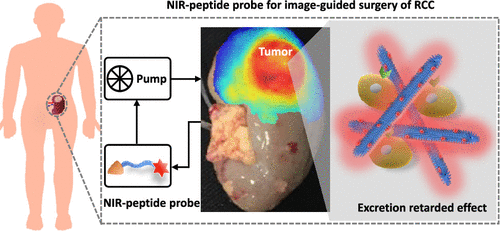Our official English website, www.x-mol.net, welcomes your
feedback! (Note: you will need to create a separate account there.)
A Near-Infrared Peptide Probe with Tumor-Specific Excretion-Retarded Effect for Image-Guided Surgery of Renal Cell Carcinoma.
ACS Nano ( IF 15.8 ) Pub Date : 2020-01-17 , DOI: 10.1021/acsnano.9b08209 Hong-Wei An 1, 2 , Dayong Hou 1, 3, 4 , Rui Zheng 1 , Man-Di Wang 1 , Xiang-Zhong Zeng 1 , Wu-Yi Xiao 1 , Tong-Da Yan 1 , Jia-Qi Wang 1, 3, 4 , Chang-Hao Zhao 1, 3, 4 , Li-Ming Cheng 3, 4 , Jin-Ming Zhang 3, 4 , Lu Wang 3, 4 , Zi-Qi Wang 1, 3, 4 , Hao Wang 1, 4 , Wanhai Xu 3, 4
ACS Nano ( IF 15.8 ) Pub Date : 2020-01-17 , DOI: 10.1021/acsnano.9b08209 Hong-Wei An 1, 2 , Dayong Hou 1, 3, 4 , Rui Zheng 1 , Man-Di Wang 1 , Xiang-Zhong Zeng 1 , Wu-Yi Xiao 1 , Tong-Da Yan 1 , Jia-Qi Wang 1, 3, 4 , Chang-Hao Zhao 1, 3, 4 , Li-Ming Cheng 3, 4 , Jin-Ming Zhang 3, 4 , Lu Wang 3, 4 , Zi-Qi Wang 1, 3, 4 , Hao Wang 1, 4 , Wanhai Xu 3, 4
Affiliation

|
Image-guided surgery plays a crucial role in realizing complete tumor removal, reducing postoperative recurrence and increasing patient survival. However, imaging of tumor lesion in the typical metabolic organs, e.g., kidney and liver, still has great challenges due to the intrinsic nonspecific accumulation of imaging probes in those organs. Herein, we report an in situ self-assembled near-infrared (NIR) peptide probe with tumor-specific excretion-retarded (TER) effect in tumor lesions, enabling high-performance imaging of human renal cell carcinoma (RCC) and achieving complete tumor removal, ultimately reducing postoperative recurrence. The NIR peptide probe first specifically recognizes αvβ3 integrin overexpressed in renal cancer cells, then is cleaved by MMP-2/9, which is up-regulated in the tumor microenvironment. The probe residue spontaneously self-assembles into nanofibers that exhibit an excretion-retarded effect in the kidney, which contributes to a high signal-to-noise (S/N) ratio in orthotopic RCC mice. Intriguingly, the TER effect also enables precisely identifying eye-invisible tiny lesions (<1 mm), which contributes to complete tumor removal and significantly reduces the postoperative recurrence compared with traditional surgery. Finally, the TER strategy is successfully employed in high-performance identification of human RCC in an ex vivo kidney perfusion model. Taken together, this NIR peptide probe based on the TER strategy is a promising method for detecting tumors in metabolic organs in diverse biomedical applications.
中文翻译:

具有肿瘤特异性排泄阻滞作用的近红外肽探针,用于肾细胞癌的图像引导手术。
图像引导手术在实现完全切除肿瘤,减少术后复发和增加患者存活率方面起着至关重要的作用。然而,由于成像探针在那些器官中固有的非特异性积累,因此在诸如肾脏和肝脏等典型的代谢器官中对肿瘤病变的成像仍然具有很大的挑战。在此,我们报道了一种在肿瘤病变中具有肿瘤特异性排泄延迟(TER)效应的原位自组装近红外(NIR)肽探针,可实现人肾细胞癌(RCC)的高性能成像并实现完整的肿瘤切除,最终减少术后复发。NIR肽探针首先特异性识别在肾癌细胞中过表达的αvβ3整联蛋白,然后被MMP-2 / 9切割,而MMP-2 / 9在肿瘤微环境中被上调。探针残留物自发地自组装成纳米纤维,在肾脏中表现出排泄延迟的作用,这有助于原位RCC小鼠的高信噪比(S / N)。有趣的是,TER效应还能够精确识别出肉眼看不见的微小病变(<1 mm),与传统手术相比,它有助于彻底清除肿瘤并显着降低术后复发。最后,在体外肾脏灌注模型中,TER策略已成功用于人RCC的高性能鉴定。综上所述,这种基于TER策略的NIR肽探针是一种在各种生物医学应用中检测代谢器官中肿瘤的有前途的方法。它有助于原位RCC小鼠的高信噪比(S / N)。有趣的是,TER效应还能够精确识别出肉眼看不见的微小病变(<1 mm),与传统手术相比,它有助于彻底清除肿瘤并显着减少术后复发。最后,在体外肾脏灌注模型中,TER策略已成功用于人RCC的高性能鉴定。综上所述,这种基于TER策略的NIR肽探针是一种在各种生物医学应用中检测代谢器官中肿瘤的有前途的方法。它有助于原位RCC小鼠的高信噪比(S / N)。有趣的是,TER效果还能够精确识别出肉眼看不见的微小病变(<1 mm),与传统手术相比,这有助于彻底清除肿瘤并显着减少术后复发。最后,在体外肾脏灌注模型中,TER策略已成功用于人RCC的高性能鉴定。综上所述,这种基于TER策略的NIR肽探针是一种在各种生物医学应用中检测代谢器官中肿瘤的有前途的方法。与传统手术相比,它有助于彻底清除肿瘤并显着减少术后复发。最后,在体外肾脏灌注模型中,TER策略已成功用于人RCC的高性能鉴定。综上所述,这种基于TER策略的NIR肽探针是一种在各种生物医学应用中检测代谢器官中肿瘤的有前途的方法。与传统手术相比,它有助于彻底清除肿瘤并显着减少术后复发。最后,在体外肾灌注模型中,TER策略已成功用于人RCC的高性能鉴定。综上所述,这种基于TER策略的NIR肽探针是一种在各种生物医学应用中检测代谢器官中肿瘤的有前途的方法。
更新日期:2020-01-17
中文翻译:

具有肿瘤特异性排泄阻滞作用的近红外肽探针,用于肾细胞癌的图像引导手术。
图像引导手术在实现完全切除肿瘤,减少术后复发和增加患者存活率方面起着至关重要的作用。然而,由于成像探针在那些器官中固有的非特异性积累,因此在诸如肾脏和肝脏等典型的代谢器官中对肿瘤病变的成像仍然具有很大的挑战。在此,我们报道了一种在肿瘤病变中具有肿瘤特异性排泄延迟(TER)效应的原位自组装近红外(NIR)肽探针,可实现人肾细胞癌(RCC)的高性能成像并实现完整的肿瘤切除,最终减少术后复发。NIR肽探针首先特异性识别在肾癌细胞中过表达的αvβ3整联蛋白,然后被MMP-2 / 9切割,而MMP-2 / 9在肿瘤微环境中被上调。探针残留物自发地自组装成纳米纤维,在肾脏中表现出排泄延迟的作用,这有助于原位RCC小鼠的高信噪比(S / N)。有趣的是,TER效应还能够精确识别出肉眼看不见的微小病变(<1 mm),与传统手术相比,它有助于彻底清除肿瘤并显着降低术后复发。最后,在体外肾脏灌注模型中,TER策略已成功用于人RCC的高性能鉴定。综上所述,这种基于TER策略的NIR肽探针是一种在各种生物医学应用中检测代谢器官中肿瘤的有前途的方法。它有助于原位RCC小鼠的高信噪比(S / N)。有趣的是,TER效应还能够精确识别出肉眼看不见的微小病变(<1 mm),与传统手术相比,它有助于彻底清除肿瘤并显着减少术后复发。最后,在体外肾脏灌注模型中,TER策略已成功用于人RCC的高性能鉴定。综上所述,这种基于TER策略的NIR肽探针是一种在各种生物医学应用中检测代谢器官中肿瘤的有前途的方法。它有助于原位RCC小鼠的高信噪比(S / N)。有趣的是,TER效果还能够精确识别出肉眼看不见的微小病变(<1 mm),与传统手术相比,这有助于彻底清除肿瘤并显着减少术后复发。最后,在体外肾脏灌注模型中,TER策略已成功用于人RCC的高性能鉴定。综上所述,这种基于TER策略的NIR肽探针是一种在各种生物医学应用中检测代谢器官中肿瘤的有前途的方法。与传统手术相比,它有助于彻底清除肿瘤并显着减少术后复发。最后,在体外肾脏灌注模型中,TER策略已成功用于人RCC的高性能鉴定。综上所述,这种基于TER策略的NIR肽探针是一种在各种生物医学应用中检测代谢器官中肿瘤的有前途的方法。与传统手术相比,它有助于彻底清除肿瘤并显着减少术后复发。最后,在体外肾灌注模型中,TER策略已成功用于人RCC的高性能鉴定。综上所述,这种基于TER策略的NIR肽探针是一种在各种生物医学应用中检测代谢器官中肿瘤的有前途的方法。











































 京公网安备 11010802027423号
京公网安备 11010802027423号